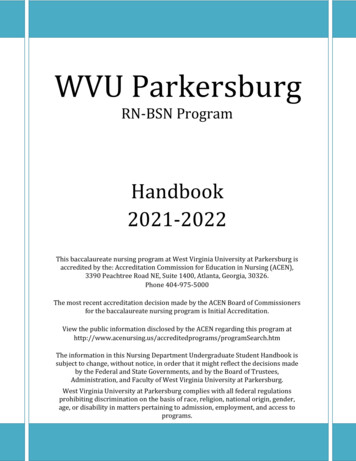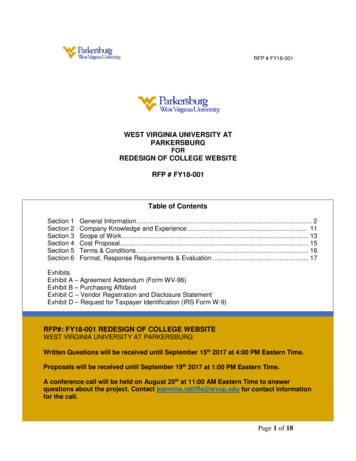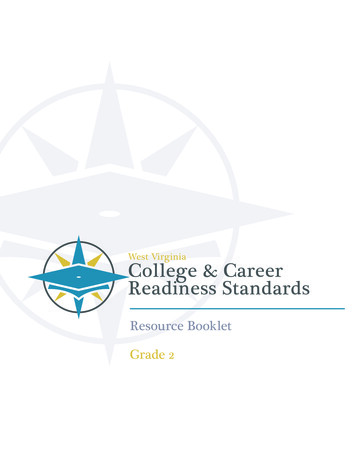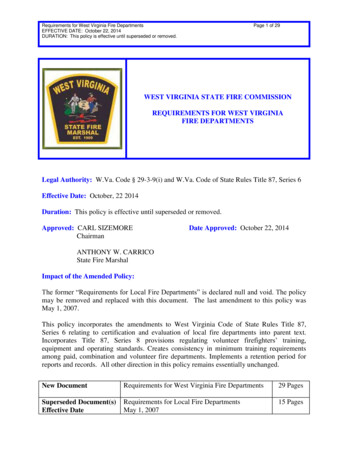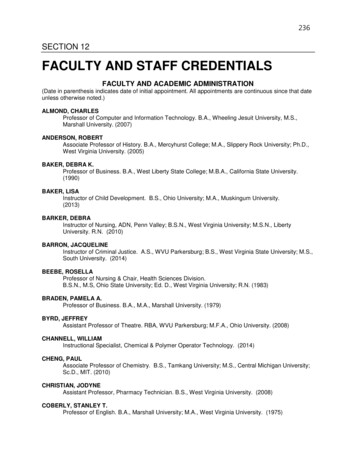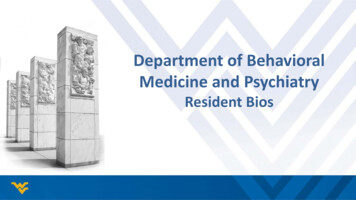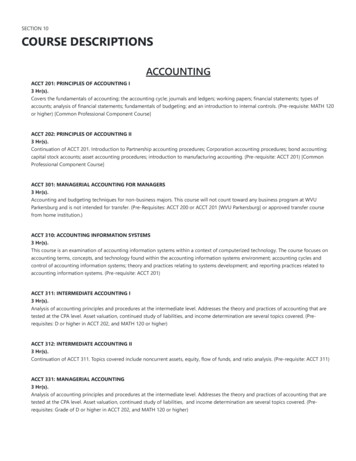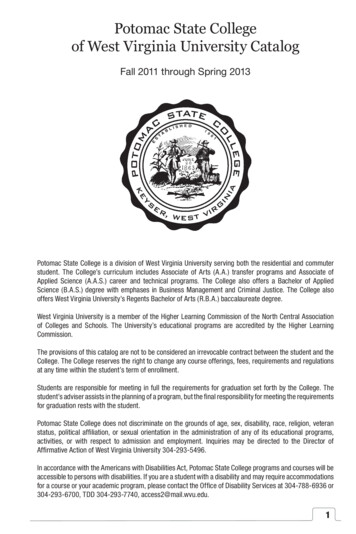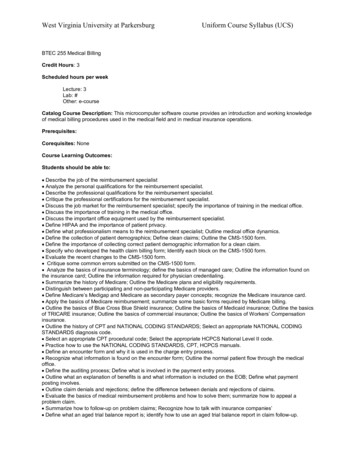
Transcription
West Virginia University at ParkersburgUniform Course Syllabus (UCS)BTEC 255 Medical BillingCredit Hours: 3Scheduled hours per weekLecture: 3Lab: #Other: e-courseCatalog Course Description: This microcomputer software course provides an introduction and working knowledgeof medical billing procedures used in the medical field and in medical insurance operations.Prerequisites:Corequisites: NoneCourse Learning Outcomes:Students should be able to: Describe the job of the reimbursement specialist Analyze the personal qualifications for the reimbursement specialist. Describe the professional qualifications for the reimbursement specialist. Critique the professional certifications for the reimbursement specialist. Discuss the job market for the reimbursement specialist; specify the importance of training in the medical office. Discuss the importance of training in the medical office. Discuss the important office equipment used by the reimbursement specialist. Define HIPAA and the importance of patient privacy. Define what professionalism means to the reimbursement specialist; Outline medical office dynamics. Define the collection of patient demographics; Define clean claims; Outline the CMS-1500 form. Define the importance of collecting correct patient demographic information for a clean claim. Specify who developed the health claim billing form; Identify each block on the CMS-1500 form. Evaluate the recent changes to the CMS-1500 form. Critique some common errors submitted on the CMS-1500 form. Analyze the basics of insurance terminology; define the basics of managed care; Outline the information found onthe insurance card; Outline the information required for physician credentialing. Summarize the history of Medicare; Outline the Medicare plans and eligibility requirements. Distinguish between participating and non-participating Medicare providers. Define Medicare’s Medigap and Medicare as secondary payer concepts; recognize the Medicare insurance card. Apply the basics of Medicare reimbursement; summarize some basic forms required by Medicare billing. Outline the basics of Blue Cross Blue Shield insurance; Outline the basics of Medicaid insurance; Outline the basicsof TRICARE insurance; Outline the basics of commercial insurance; Outline the basics of Workers’ Compensationinsurance. Outline the history of CPT and NATIONAL CODING STANDARDS; Select an appropriate NATIONAL CODINGSTANDARDS diagnosis code. Select an appropriate CPT procedural code; Select the appropriate HCPCS National Level II code. Practice how to use the NATIONAL CODING STANDARDS, CPT, HCPCS manuals. Define an encounter form and why it is used in the charge entry process. Recognize what information is found on the encounter form; Outline the normal patient flow through the medicaloffice. Define the auditing process; Define what is involved in the payment entry process. Outline what an explanation of benefits is and what information is included on the EOB; Define what paymentposting involves. Outline claim denials and rejections; define the difference between denials and rejections of claims. Evaluate the basics of medical reimbursement problems and how to solve them; summarize how to appeal aproblem claim. Summarize how to follow-up on problem claims; Recognize how to talk with insurance companies’ Define what an aged trial balance report is; identify how to use an aged trial balance report in claim follow-up.
West Virginia University at ParkersburgUniform Course Syllabus (UCS) Outline account receivable; discuss the billing cycle; define the medical office collection process. Examine the importance of communication skills when collecting reimbursement. Examine the importance of consistent medical office collection policies; define the federal and state collection laws. Outline how to develop a professional resume ; prepare a cover letter; prepare a thank you letter and define why itis important. Prepare for an interview; Explain why the appointment schedule is important; define patient eligibility. Describe a source document and discuss its roll in data entry. Identify five source documents routinely used in themedical office; discuss the function of the encounter form; describe three methods for collecting insurance payments. Evaluate several types of health insurance coverage; name and describe three types of health insurance plan;discuss managed care insurance coverage. Critique the role of computers in today’s medical office; describe the purposed of The Medical Manager software. Start the Medical Manager system; input and process data; print reports from support files; back up the daily datafiles; navigate effectively through the Medical Manager software. Identify all sections and data elements of the patient registration form. Discuss the names and purposes of the primary and supplemental data screens. Using the patient registration form, identify all data elements that should be entered in to the primary data screen(s). Discuss the importance of entering data correctly; discuss the relationship of the guarantor and the patient. Explain the essential difference between creating a new patient account compared to adding a new dependent toan existing patient account; explain the purpose of extended information. Identify and discuss the relationship between the two key elements of patient insurance information. Discuss how the help windows may be used; identify various parts of an encounter form; retrieve patient accounts. Post procedure codes and diagnosis codes under varying circumstances. Define the meaning of an ailment; describe how an ailment is used by insurance companies; create and apply anailment. Identify the three concepts of posting procedures to an account; explain the process of posting procedures to anaccount. Identify elements of the Procedure Posting screen; explain the concept of medical necessity and the role it playswith insurance payments; describe the importance of performing a Trial Daily balance; perform the Daily Close;advance the system date. Retrieve a patient account; modify or correct account or patient information; retrieve and modify a referring doctor;retrieve a previously posted charge; modify or correct a previously posted charge; retrieve and modify an ailment. Explain the procedure for scheduling and canceling individual and multiple appointments. Make follow-up appointments from encounter forms; explain the (J)ump command; demonstrate the (J)umpcommand; demonstrate how to navigate by days; demonstrate how to locate existing appointments. Explain the purpose and importance of the daily list of appointments and print the list; explain the purpose andimportanceof the Hospital Rounds Report; enter information into a Hospital Rounds Report. Discuss what you expect the doctor to write on the Hospital Rounds Report; print the Hospital Rounds Report; usehelp windows to locate procedure and diagnosis codes for hospital (Out of Office) charges; explain how the HospitalRounds Report can be used in place of an encounter form. Describe why insurance billing is important; explain why an Insurance Billing Worksheet should be prepared inadvance of billing; prepare an Insurance Billing Worksheet; interpret the information on an Insurance BillingWorksheet. Print claim forms for insurance companies; post payments from patients and insurance carriers; make postingadjustments from the Procedure Entry screen; make posting adjustments from the Payment Entry screen; voidprocedures. Describe why the system date should not be advanced except after a daily close or when instructed to in the text. Locate and interpret information from an insurance plan’s Explanation of Benefits. Describe the information to be processed at each portion of the Payment Entry screen; learn how to manageinsurance billing. Describe the functions of the Guarantor’s Financial Summary Report; describe the function of the Current PeriodReport. Describe the function of the System Summary Report; print the Guarantor, Current Period, and System SummaryReports. Explain several methods for billing patients on a regular basis; print patient statements. Discuss three unique payment situations and describe how each situation should be handled; post a variety ofunique payments; discuss the account aging process; name and discuss several types of patient data that can beretrieved and displayed; display and print patient data; explain the purpose and importance of Period Close andpurge.
West Virginia University at ParkersburgUniform Course Syllabus (UCS) Describe the importance of Health Information Technology (HIT) systems in a medical office; explain how HITassists offices with changes in health care; discuss the role of HIT in communicating medical information; discuss theclinical aspects of the medical office; describe the Health Insurance Portability and Accountability Act (HIPAA) PatientPrivacy Regulations in the medical office; describe additional modules of The Medical Manager system and how theyinterrelate.Topics to be studied: A career as a Reimbursement Specialist; accounts receivable; personal qualifications; professional qualifications;certifications available; the Job Market. Office Training; information exchange; the medical record; office equipment; office policies and HIPAA;professionalism. Patient Information; clean claims; office dynamics; making the appointment; check-in; clinical services; checkout;claim submission; cash flow. CMS-1500 Form; patient information; CMS-1500 form layout; instructions for completing the form; CMS-1500 formsubmission; multiple Insurances. Health Insurance; reimbursement terminology; managed care; types and credentialing. Medicare overview, history of Medicare; Medicare eligibility; Medicare plans; Medigap; Medicare as a SecondaryPayer; Medicare Secondary Payer Questionnaire; Medicare Reimbursement; Participating Physicians; MedicareRules and Regulations; excluded services; fraud and abuse; rules and regulations resources; reimbursementprocess; Billing Medicare on the CMS-1500 form. Blue Cross Blue Shield, Medicaid, TRICARE, Commercial, and Workers’ Compensation Insurances; History of BlueCross Blue Shield, BCBS plans; physician participation; Medicaid eligibility, covered services, Medicaid ClaimSubmission; TRICARE, History of TRICARE Insurance, TRICARE plans, TRICARE billing, CHAMPVA; History ofWorkers’ Compensation Insurance, Federal Workers’ Compensation Programs, State workers’ CompensationPrograms, office procedures, insurance summary. Coding Overview of CPT and NATIONAL CODING STANDARDS Coding, History Manual, steps to coding, Volume2: Index and Tabular Listings, Volume 1: Tabular List of Diseases, Guidelines; CPT Coding, CPT manual, CPTManual format, CPT modifiers, CPT unlisted Codes, Additional information in the CPT manual, coding with the CPTmanual; HCPCS National Level II Codes. Charge Entry, encounter forms, patient flow in the Medical Office, auditing, documentation, fraud vs. Abuse,compliance training. Payment entry, explanation of benefits, payment posting, denials and rejections, secondary insurances. Problem solving, understanding reimbursement problems, appeals, talking with the Insurance Company. Aged trial balance reports, account receivable, aged trial balance reports, the billing cycle, implantation of the AgedTrial Balance Report, resulting reimbursement problems. Collections, payment at the time of services, outstanding balances, write-offs, collection agencies, federal and statecollection laws. Resume and interviews, contact information, summary of qualifications. Objective, education, skills, experience,the cover letter, a professional presentation, preparing for the interview, interview questions, the interview process,the thank you letter. Flow of patient information, managed care, adding a referring doctor to Medical Manager, printing support fiereports to the computer screen, using the print screen feature to capture a portion of a report sent to the console,backup student files to the my documents folder, backup student files to the USB storage device. Enter patients with multiple insurance plans, adding patients with extended information, adding accounts withdependents, adding accounts with dependents that have different insurance plans, adding an account with differentcoverage priorities, patients with different names and different insurances, comprehensive exercise, generating aNew Guarantor’s Full Report. Posting procedures to a Guarantor, a dependent, posting multiple procedures to a patient with a different last namethan the guarantor, posting a procedure for a work-In patient, posting four charges, multiple procedures with differentdiagnoses, two procedures requiring ailment details, posting an ailment with three charges, posting a procedurewithout insurance, printing the ailment file report, performing a trial daily report, performing a final daily close,advancing the date. Modifying a guarantor’s information, editing patient records, adding an insurance plan and insurance group number,adding dependents to an existing account, posting charges for a new dependent, editing activity in a patient record;updating doctor/practice files. Scheduling appointments, scheduling in multiple time slots, with different doctors, rescheduling an appointment,canceling an appointment, printing an appointment, printing the Hospital Rounds Report, performing a final dailyclose, Removing a patient from the hospital rounds report. Printing an insurance billing worksheet, correcting diagnosis codes, posting procedures and payments separately,running the insurance pre-billing worksheet, posting payments from Payment Entry Screen, posting a payment using
West Virginia University at ParkersburgUniform Course Syllabus (UCS)patient checkout payments, preventing billing, voiding transactions, posting negative adjustments: increasing thePatient’s balance, using the transfer option to change responsibility without affecting the balance, posting patientpayment using automatic crediting, posting a Medicare payment: dual insurance coverage, posting a Medicarepayment: Patient deductible, posting insurance payment split between patients, posting insurance payment withsettlement options, posting an overpayment to unapplied credit. Analyze New guarantors’ summary report, Guarantor’s summary report – unapplied credit, summary current periodreport, system financial summary report, print patient statements, general ledger transfer/distribution report. Refund an overpayment, remove credit for a bad check, auto pay insurance mode, using adjustment for zero dollarsto rebill a lost claim, adding a patient to hospital rounds. Change consent, running patient consent reports,authorization for releaseof information, recording release of information, recording a disclosure.Special projects or requirements of the course: Advanced Hands-on Projects that covers Medical Office procedures based on real world electronic medicaloffice software applications; enter real-world patient information, post payments; post charges; edit patientinformation and print billing and office reports. Prepare appointment schedules with a variety of doctors; prepare Medical Office Reports accurately withintime constraints. Quizzes and hands on demonstration of skills. Research/written reports, discussion of case studies. Comprehensive simulationRelationship of Course to Program or Discipline Learning Outcomes:Associate of Applied Science in Business Technology (BTEC) Program Outcomes:At the conclusion of the AAS in Business Technology program, students will:Communicate effectively and professionally both orally and in writing within the context ofthe business world in an administrative role.Demonstrate competence in the use of electronic tools: hardware and software-to research,manage, and present information.Utilize word processing software such as MS Word to design professional quality documents(reports, memos, etc.), including the ability to import and appropriately integrate tables andgraphics.Utilize spreadsheet software such as MS Excel to manipulate and analyze data, includingbasic operations on cells and cell ranges, formulas and functions, filters, sorts, and developgraphs and charts.Utilize presentation software such as MS PowerPoint to present information in anappropriate and sophisticated manner, including design templates, color and animationschemes, custom animation, and importation of charts, tables, and graphics.Demonstrate the ability to work ethically, effectively, and respectfully with people of diversebackgrounds and with people who have different roles, social affiliations, and personalities.Be prepared for admission to the Bachelor of Applied Science in Business Administrationwith a Business Information Technology (BIT) concentration at WVU at Parkersburg.Relationship of Course to General Education Learning Outcomes:XXXX
West Virginia University at ParkersburgUniform Course Syllabus (UCS)Composition and Rhetoric Students illustrate a fundamental understanding of the best practicesof communicating in English and meet the writing standards of their college or program-basedcommunication requirements.Science & Technology Students successfully apply systematic methods of analysis to the naturaland physical world, understand scientific knowledge as empirical, and refer to data as a basis forconclusions.Mathematics & Quantitative Skills Students effectively use quantitative techniques and thepractical application of numerical, symbolic, or spatial concepts.XSociety, Diversity, & Connections Students demonstrate understanding of and a logical ability tosuccessfully analyze human behavior, societal and political organization, or communication.Human Inquiry & the PastStudents interpret historical events or philosophical perspectives by identifying patterns,applying analytical reasoning, employing methods of critical inquiry, or expanding problemsolving skills.The Arts & CreativityStudents successfully articulate and apply methods and principles of critical and creative inquiryto the production or analysis of works of art.10/20/2107Additional information: Students must pass this course with a “C” or better to receive the Medical Office Assistantor Insurance Certificate. BTEC courses require a C or better for Certificates, Associate’s Degree, and BASBA MajorConcentration.Prepared by: Carol C. Thomas, ProfessorDate: October 20, 2017
BTEC 255 Medical Billing . Credit Hours: 3 . Scheduled hours per week . Lecture: 3 . Lab: # Other: e-course . Catalog Course Description: This microcomputer software course provides an introduction and working knowledge of medical billing procedures used in the medical field and in medical insurance operations. Prerequisites: Corequisites: None
